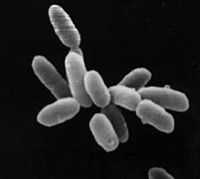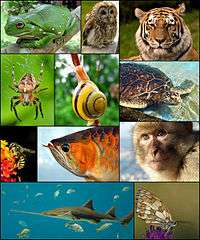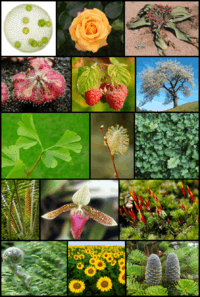Biology

On the right is a drawing of the archaean Haloquadratum walsbyi.
Biology is the study of living organisms, divided into many specialized fields that cover their morphology, physiology, anatomy, behavior, origin, and distribution.
Most of Wikiversity's content on Biology can currently be found via the School:Biology page.
Theoretical biology
Def. the "study of all life or living matter"[1] is called biology.
Zoology

Def. "that part of biology which relates to the animal kingdom, including the structure, embryology, evolution, classification, habits, and distribution of all animals, both living and extinct"[2] is called zoology.
Botany
Def. "[t]he scientific study of plants, ... [t]ypically those disciplines that involve the whole plant"[3] is called botany.
Usage notes:
"The scientific definition of what organisms should be considered plants changed dramatically during the 20th century. Bacteria, algae, and fungi are no longer considered plants by those who study them. Many textbooks do not reflect the most current thinking on classification."[4]
Archaeaology

"This path has attracted 'archaeaologists' with great tenacity and drive, impressive creativity and dynamic thinking, and a capacity to expand a mental comfort zone to broker remarkable observations, often in view of reluctant acceptance."[5]
Def. the scientific study of the archaea is called archaeaology.
"The B recognition element (BRE) is a DNA sequence found in the promoter region of most genes in eukaryotes and Archaea.[6][7]"[8]
In the archaean from the Dead Sea imaged at the right, "We have completely fragmented their DNA. I mean we have completely destroyed it by bombarding it with [radiation]. And they can reassemble their entire chromosome and put it back into working order within several hours."[9]
Taxonomy


- Superregnum Archaea,
- Superregnum Bacteria, and
- Superregnum Eukaryota.[10]
Superregnum: Archaea[11]
Regnum (Phyla):
- Crenarchaeota
- Euryarchaeota
- Korarchaeota
Superregnum: Bacteria[12]
Phyla
- Acidobacteria
- Actinobacteria
- Aquificae
- Chlamydiae
- Chloroflexi
- Chrysiogenetes
- Cyanobacteria
- Deferribacteres
- Deinococcus-Thermus
- Dictyoglomi
- Fibrobacteres
- Firmicutes
- Fusobacteria
- Gemmatimonadetes
- Nitrospirae
- Planctomycetes
- Proteobacteria
- Spirochaetes
- Thermodesulfobacteria
- Thermotogae
- Verrucomicrobia
Superregnum: Eukaryota[13] Regnums (Whittaker & Margulis, 1978): Animalia - Plantae - Fungi - Protista Regnums (Cavalier-Smith, 1981): Animalia - Plantae - Fungi - Chromista - Protozoa
Regnum: Animalia Phyla (36):
- Acanthocephala
- Annelida
- Arthropoda
- Brachiopoda
- Bryozoa
- Cephalorhyncha
- Chaetognatha
- Chordata
- Cnidaria
- Ctenophora
- Cycliophora
- Echinodermata
- Echiura
- Gastrotricha
- Gnathostomulida
- Hemichordata
- Kamptozoa
- Kinorhyncha
- Loricifera
- Micrognathozoa
- Mollusca
- Myxozoa
- Nematoda
- Nematomorpha
- Nemertea
- Onychophora
- Orthonectida
- Phoronida
- Placozoa
- Platyhelminthes
- Porifera
- Rhombozoa
- Rotifera
- Sipuncula
- Tardigrada
- Xenacoelomorpha
Regnum: Plantae[14] Divisiones (8): "Algae" (first four)
- Charophyta
- Chlorophyta
- Glaucophyta
- Rhodophyta
- Anthocerotophyta
- Bryophyta
- Marchantiophyta
- Tracheophyta
Popular Wikiversity Courses & Content
Popular Topics
Topics are also departments within the school of biology.
- Topic:Cell biology
- Topic:Marine biology
- Topic:Structural biology
See also
- Cell biology improvement drive
- Eukaryotes
- Evolution
- Human DNA
- Human RNA
- Mathematical molecular biology
- Portal:Life Sciences
- School:Biology
- What is a human?
References
- ↑ "biology, In: Wiktionary". San Francisco, California: Wikimedia Foundation, Inc. 23 February 2015. Retrieved 2015-02-23.
- ↑ "zoology, In: Wiktionary". San Francisco, California: Wikimedia Foundation, Inc. May 8, 2014. Retrieved 2014-05-18.
- ↑ "botany, In: Wiktionary". San Francisco, California: Wikimedia Foundation, Inc. July 18, 2012. Retrieved 2012-08-07.
- ↑ "plant, In: Wiktionary". San Francisco, California: Wikimedia Foundation, Inc. August 7, 2012. Retrieved 2012-08-07.
- ↑ Ricardo Cavicchioli (January 2011). "Archaea—timeline of the third domain". Nature Reviews Microbiology 9 (1): 51-61. http://www.nature.com/nrmicro/journal/v9/n1/full/nrmicro2482.html. Retrieved 2015-02-23.
- ↑ Lagrange T, Kapanidis AN, Tang H, Reinberg D, Ebright RH (1998). "New core promoter element in RNA polymerase II-dependent transcription: sequence-specific DNA binding by transcription factor IIB". Genes & Development 12 (1): 34–44. doi:10.1101/gad.12.1.34. PMID 9420329. PMC 316406. //www.ncbi.nlm.nih.gov/pmc/articles/PMC316406/.
- ↑ Littlefield O, Korkhin Y, Sigler PB (1999). "The structural basis for the oriented assembly of a TBP/TFB/promoter complex". Proceedings of the National Academy of Sciences of the USA 96 (24): 13668–73. doi:10.1073/pnas.96.24.13668. PMID 10570130. PMC 24122. //www.ncbi.nlm.nih.gov/pmc/articles/PMC24122/.
- ↑ "B recognition element, In: Wikipedia". San Francisco, California: Wikimedia Foundation, Inc. January 30, 2013. Retrieved 2013-01-30.
- ↑ Adrienne Kish (September 10, 2004). "Secrets of a Salty Survivor A microbe that grows in the Dead Sea is teaching scientists about the art of DNA repair". Washington, DC USA: NASA. Retrieved 2014-05-15.
- ↑ "Main Page, In: Wikispecies". San Francisco, California: Wikimedia Foundation, Inc. 17 January 2016. Retrieved 2016-01-21.
- ↑ "Archaea, In: Wikispecies". San Francisco, California: Wikimedia Foundation, Inc. 22 November 2015. Retrieved 2016-01-21.
- ↑ "Bacteria, In: Wikispecies". San Francisco, California: Wikimedia Foundation, Inc. 22 November 2015. Retrieved 2016-01-21.
- ↑ "Eukaryota, In: Wikispecies". San Francisco, California: Wikimedia Foundation, Inc. 13 November 2015. Retrieved 2016-01-21.
- ↑ "Plantae, In: Wikispecies". San Francisco, California: Wikimedia Foundation, Inc. 5 December 2015. Retrieved 2016-01-21.
External links
- GenomeNet KEGG database
- Home - Gene - NCBI
- NCBI All Databases Search
- NCBI Site Search
- WikiDoc The Living Textbook of Medicine
| |||||||||||||||||||||||||||||||||||||||||||||||||||||
| |||||||||||||||||||||||||||||||||||||||||
| ||||||||||||||||||||||||||||||||||||||||||||
| |||||||||||||||||||||||||||||||||||
| ||||||||||||||||||||||||||||||||||||||
| |
Subject classification: this is a science resource . |
| |
Subject classification: this is a biology resource . |